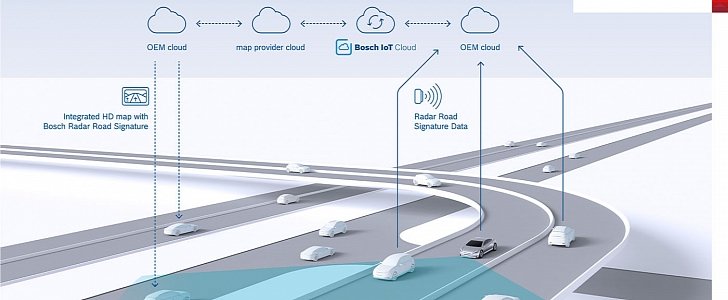Considering it was one of the first companies to get involved in the development of autonomous cars - I rode in one of their self-driving BMW 3 Series Touring five years ago - Bosch has been awfully quiet lately.
But that doesn't mean it's been completely dormant. When it's not busy providing parts for almost the entire car-making industry, it would seem, the German company fills its time with inventing new mapping techniques.
Right now, vehicle localization is done exclusively using video data, but this has a few obvious limitations. Its efficiency in the dark and under adverse weather conditions is limited. The volume of data that gets sent to the cloud is also high due to the complex nature of the video format.
Bosch and Dutch satnav specialist TomTom are proposing a system based on radar technology. The "radar road signature" is made up of the countless reflection points as the radar waves hit any obstacle in their way. The autonomous vehicles can thus pinpoint their position on the road with much greater accuracy - down to a few centimeters, according to Bosch.
“The radar road signature is a milestone on the path towards automated driving. It will enable automated vehicles to reliably determine their location at all times,” says Bosch board of management member Dr. Dirk Hoheisel. In return, TomTom CEO Harold Goddijn declared: “The radar road signature is a milestone on the path towards automated driving. It will enable automated vehicles to reliably determine their location at all times.”
The advantages of the radar system over its video sensors-based peer stretch further than its imperviousness to outside conditions. With a maximum reach of up to 250 meters, it surpasses video data detection with a full 100 meters, while the volume of data sent over the air is halved.
Bosch is currently the main provider of radar systems for the automotive industry, but those used in the adaptive cruise control modules or for automated braking are calibrated to detect moving objects. The new ones would have to pick up stationary ones as well, and Bosch says they will begin to roll out in new vehicles over the coming years.
The two companies claim that the first bytes of data for the radar road signature will be provided no later than 2020 in both Europe and the U.S.
Right now, vehicle localization is done exclusively using video data, but this has a few obvious limitations. Its efficiency in the dark and under adverse weather conditions is limited. The volume of data that gets sent to the cloud is also high due to the complex nature of the video format.
Bosch and Dutch satnav specialist TomTom are proposing a system based on radar technology. The "radar road signature" is made up of the countless reflection points as the radar waves hit any obstacle in their way. The autonomous vehicles can thus pinpoint their position on the road with much greater accuracy - down to a few centimeters, according to Bosch.
“The radar road signature is a milestone on the path towards automated driving. It will enable automated vehicles to reliably determine their location at all times,” says Bosch board of management member Dr. Dirk Hoheisel. In return, TomTom CEO Harold Goddijn declared: “The radar road signature is a milestone on the path towards automated driving. It will enable automated vehicles to reliably determine their location at all times.”
The advantages of the radar system over its video sensors-based peer stretch further than its imperviousness to outside conditions. With a maximum reach of up to 250 meters, it surpasses video data detection with a full 100 meters, while the volume of data sent over the air is halved.
Bosch is currently the main provider of radar systems for the automotive industry, but those used in the adaptive cruise control modules or for automated braking are calibrated to detect moving objects. The new ones would have to pick up stationary ones as well, and Bosch says they will begin to roll out in new vehicles over the coming years.
The two companies claim that the first bytes of data for the radar road signature will be provided no later than 2020 in both Europe and the U.S.

